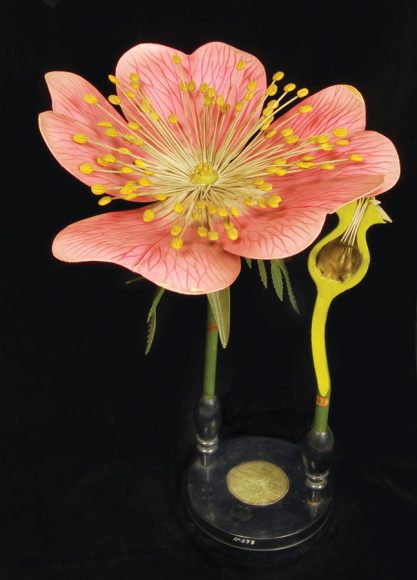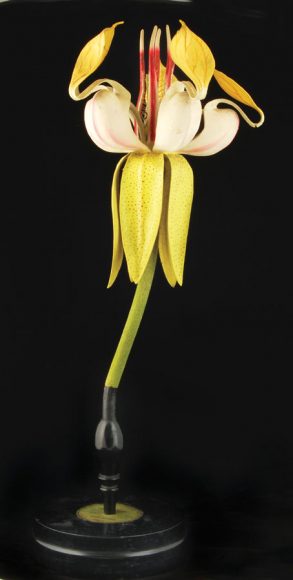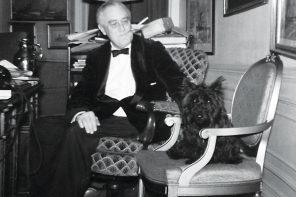When it comes to nature, the Cooper Hewitt, Smithsonian Design Museum in Manhattan is all in.
Indeed, nature is the theme of its sixth triennial of nine exhibits, which are rolling out through May of next year. Featuring more than 210,000 examples of textiles, jewelry, furniture, cutlery and more from the museum’s collection, “Nature — Cooper Hewitt Design Triennial” is all about “how designers engage with nature,” said Julia Siemon, the museum’s assistant curator of drawings, prints and graphic design, who toured us through two of the shows recently. “I think there’s a sense of emergency and immersion in nature in the shows,” she added, but not in a doom-and-gloom kind of way. While acknowledging the environmental challenges the world now faces, she called the relationship between the shows’ artisans and nature one of “optimistic engagement.”
Clearly that is true in the two shows we saw, which represent a pair of complements — East and West; the everyday and the aristocratic. “Katagami” (through Oct. 27) explores the traditional (17th through 20th century) and contemporary practice of creating stencils to depict irises, bamboo, hollyhocks and other botanicals on fabric for the workaday Japanese, who were forbidden the loftier art of embroidery, Siemon said. The stencils — carved out of pounded mulberry bark treated with fermented persimmon juice for strong, waterproof flexibility — are placed on a prepared fabric and covered in a “resist,” or dye-resistant rice paste. The fabric is then dyed, usually with natural indigo, with the color adhering only to the areas not protected by the resist. When it’s washed away, all that remains on the textile is the stencil’s design.
In contrast to the simple beauty of “Katagami,” “Embroidered and Embellished” (through Oct. 27) conjures the fanciful, formalized world of 18th-century French nobility, in which an embroidered silk waistcoat was not merely a waistcoat, but an emblem of power, status, respect and wealth. The properly attired aristocrat needed hundreds of them for different occasions, not the least of which was the hunt, in which the waistcoat might depict the particular animal being hunted.
Fauna both imaginary and realistic meets flora, along with frolicking nymphs and other figures in these designs, in which the threads still gleam on pristine creamy backgrounds, thanks to Richard C. Greenleaf. In the early 20th century, he assembled one of the most significant collections of European textiles and lace in the United States. A majority of the waistcoats and samples on view were bequeathed by him to the museum, which was founded in 1897 by sisters Sarah Cooper Hewitt and Eleanor Garnier Hewitt and, since 1970, has been located in the Georgian Revival Andrew Carnegie House, whose charming courtyard garden was just beginning to stir when we visited.
Our deadlines for this issue prohibited us from getting more than a glimpse between the partitions that signaled an installation in progress for “Paisley” (through Nov. 11), which explores the irresistible tear-drop motif’s relationship with flowering plants, Persia, India, Kashmir shawls and the Scottish town — famed for its imitation Kashmir shawls in the 18th and 19th centuries — from which it gets its name. Shimmering designs by clothing, home and fragrance powerhouse Etro bring this favorite pattern up to date.
June finds plant life and coral going underwater for “Bathing Beautiful” (June 8 through May 3, 2020). It considers the use of marine designs in bathroom wallcoverings, which began to move from the sterile and hygienic to the playful and aquatic around 1910 as the large-scale, watercolor-like design — albeit with waterproof, oil-based inks — for an alcove gallery suggests.
Running concurrently is “Natural Plastics,” which gets to the heart of what Siemon was talking about in our tour of “Katagami” and “Embroidered and Embellished.” Designers have celebrated nature through their creations and use of natural materials, included malleable tortoiseshell, vulcanized rubber, bioplastic pellets, strong leather and semi-synthetics like rayon and celluloid.
But the popularity and depletion of organic plastics led to the creation of new synthetic versions that have created environmental hazards. Today, designers have gone back to the future, using traditional and nontraditional natural materials for biodegradable and renewable bioplastics in everything from packaging to home goods.
Cooper Hewitt continues its triennial with “Cochineal” (Nov. 9 through Jan. 3, 2020), which looks at the use of the cochineal insect from pre-Hispanic times to the mid-19th century to create the spectrum of reddish pigments that helped define the textiles, lacquered furnishings and works on paper of the Americas; and the concurrent “After Icebergs,” celebrating the 160th anniversary of Hudson River School painter Frederic Edwin Church’s Newfoundland expedition and the magisterial works it produced.
The triennial closes with “Botanical Expressions” (Dec. 7 through June 14, 2020), centering on key figures in the decorative arts from the 18th through early 20th centuries — Christopher Dresser, Emile Gallé, William Morris, and Louis Comfort Tiffany — who drew on a passion for the natural sciences and love of gardening in their textiles, ceramics, glassworks and wallcoverings. Among the loans from Smithsonian Libraries are the illustrated guidebooks that the designers used for reference.
For more, visit cooperhewitt.org.






